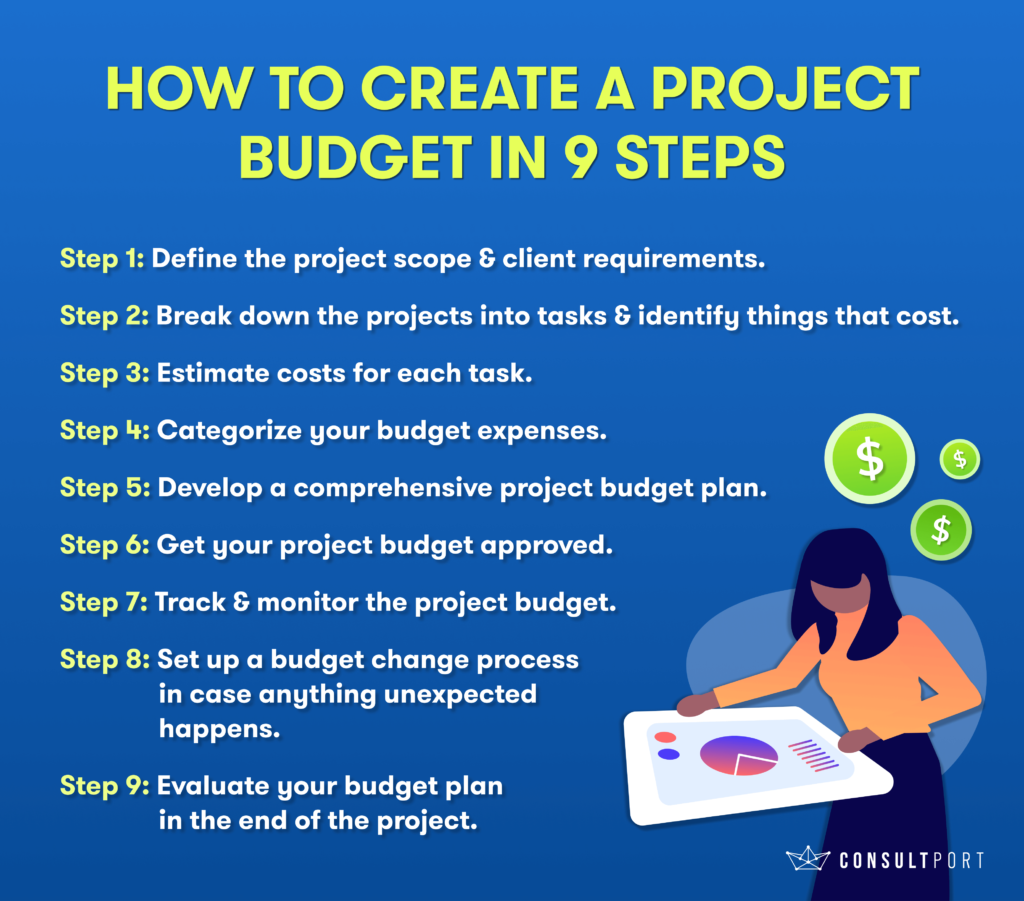Proven Strategies for Developing a Project Budget
Blog Categories:
Published:
May 8, 2023
Reading Time:
7 minutes

Proven Strategies for Developing a Project Budget
Being a project manager is never an easy job. I’ve been asked tons of questions about how to run a project effectively. Among that, one of the most popular questions is how to develop a project budget that both makes customers satisfied and maximize your ROI percent.
Well, I have to say… Even though I have managed budgets for hundreds of projects, it’s still a challenge for me when developing a budget plan for a new project. Fortunately, there are some proven strategies that turn your hard work into a piece of cake. In this blog, I’ll go to introduce you in detail about these strategies so you can apply them to your current projects.
Being a project manager is never an easy job. I’ve been asked tons of questions about how to run a project effectively. Among that, one of the most popular questions is how to develop a project budget that both makes customers satisfied and maximize your ROI percent.
Well, I have to say… Even though I have managed budgets for hundreds of projects, it’s still a challenge for me when developing a budget plan for a new project. Fortunately, there are some proven strategies that turn your hard work into a piece of cake. In this blog, I’ll go to introduce you in detail about these strategies so you can apply them to your current projects.
What is a project budget?
First, let’s dig into the basic definition of “project budget." Simply put, a project budget is the total cost for all tasks, activities, and resources needed to complete a project, starting from the preparation stage to the closing stage (which is defined in the client contract).
Therefore, the person in charge of developing a project budget will have the responsibility of predicting, estimating, tracking, and optimizing the spending amount. In the end, the core goal of carrying out a project is to make profits, right? So, if all the efforts of your whole team do not return worthy rewards, or even worse, nothing, the project is normally considered a “failure”.
Basically, to develop a project budget functionally, you need to address two main things: time and resources. The more accurately you can estimate the cost, the more smoothly your project will run. A lot of projects just fall apart when the budget runs out in the middle of the implementation.
However, it does not mean you can easily raise your budget as much as possible. Your clients will not be happy with the price, so they will leave for other service providers who offer more reasonable options. It is really a work of art to establish a win-win relationship between customer satisfaction and your team's benefits.
Therefore, the person in charge of developing a project budget will have the responsibility of predicting, estimating, tracking, and optimizing the spending amount. In the end, the core goal of carrying out a project is to make profits, right? So, if all the efforts of your whole team do not return worthy rewards, or even worse, nothing, the project is normally considered a “failure”.
Basically, to develop a project budget functionally, you need to address two main things: time and resources. The more accurately you can estimate the cost, the more smoothly your project will run. A lot of projects just fall apart when the budget runs out in the middle of the implementation.
However, it does not mean you can easily raise your budget as much as possible. Your clients will not be happy with the price, so they will leave for other service providers who offer more reasonable options. It is really a work of art to establish a win-win relationship between customer satisfaction and your team's benefits.
KEY TAKEAWAYS
- Almost all consultants/project managers face challenges in developing a project budget that works. The struggle here is to maximize profits while still keeping your clients satisfied
- A project budget includes all the costs and expenses required to complete a project. To manage the budget, the project managers not only make a list of them, but also perform tracking, analyzing, and optimizing activities.
Types of budget costs
Types of budget costs can vary in different businesses/domains. However, here are some general categories for all kinds of projects:
- Material costs: List any supplies required to deliver the project here, including things like software tools or rented equipment.
- Travel costs: Include all necessary expenses for the team to travel between places for project-related activities.
- Labor costs: Calculate your project team’s compensation, which includes salaries, hourly wages, healthcare benefits, and payroll taxes. Adopting a time-based approach to billing clients for labor is quite a popular option.
- Professional service costs: Sometimes you need external support to carry out tasks beyond the scope of the project team’s expertise. So, put expenses incurred from working with third-party partners here.
- Other additional costs: If you cannot decide whether an expense belongs to one of the above categories, list it here.
Proven strategies and techniques to develop a project budget
To deal with a complicated task like making a project budget plan, you better know about the top 4 strategies and techniques that most project managers are familiar with.
Expert judgment
With this technique, you would need to ask for advice from an expert/consultant with relevant experience. It is extremely helpful in case you don’t have historical data as a reference to define a similar approach or your team is still new to tasks/domains. The expert can be an internal employee or hired from external sources.- Advantages:
- Take advantage of experts to avoid common mistakes for newbies.
- Easily select suitable professionals to suit the specific domain/business context.
- Disadvantages:
- Subjectivity: All advice will be based on personal views and opinions.
Analogous estimation
Based on the previous projects in your team, you can look for similarities to estimate a budget for the current project. You don’t just take a quick look; you need to go into details for data-driven decisions.- Advantages:
- Self-control management with transparency.
- Suitable to implement for all kinds of projects.
- Disadvantages:
- Require a data analysis toolset.
Top-down estimating
The technique of top-down estimating involves analyzing the overarching project scope and budget without delving into the finer details of the work in order to produce a rough estimate.- Advantages:
- Avoid wasting time on the small details of projects.
- Provide an easy-to-understand overview for both clients and your team members.
- Disadvantages:
- Some costs may be missed if the owner of the project budget does not have enough information.
Bottom-up estimating
Contrary to the top-down technique, the approach of bottom-up estimating involves breaking down the project into individual tasks and considering the time, cost, and effort required for each one. These individual estimates are then combined to create an overall estimate for the entire project.- Advantages:
- All tasks and activities will be covered sufficiently.
- Cost estimation of each task can be assigned to different person with the right expertise.
- Disadvantages:
- Going to details can be time-consuming.
How to Create a Project Budget Plan
A common procedure for budgeting a project could resemble the following:Step 1. Define the project scope and client requirements. To properly manage a project budget, the initial step requires a thorough understanding of what is needed to successfully complete the project. This information should be gathered during the project's discovery phase. Once all project requirements have been collected, the project scope can be accurately defined. Defining the project scope provides valuable insights, such as the necessary resources, deliverables, tasks, and timeline. Additionally, it ensures that all client requests are taken into account.
Step 2. Break down the projects into tasks and identify things that cost money. To guarantee that you allocate funds for all your expenses, it is advisable to divide your project into phases and, subsequently, break down the activities and subtasks within each phase.
Step 3. Estimate costs for each task. It's crucial to keep track of the anticipated expenses for every project task, estimating how much time your team will need to complete them. This will enable you to allocate funds for their time and factor in the total cost of the project.
Step 4. Categorize your budget expenses. Arranging your expenditures into categories can aid in determining which ones take precedence. This is especially advantageous in case your client requests that you reevaluate your budget and decrease your expenses. By doing this, you'll have an understanding of which categories are vital to the accomplishment of your project, and which ones can be reduced.
Step 5. Develop a comprehensive project budget plan. After categorizing all budget items, it's time to merge them to form your project budget. Remember to include all expenses, time-based or flat-fee costs, in your calculation. In addition to this, creating a timeline indicating when you plan to spend the funds during this step in your budgeting process can be advantageous. It helps in planning and also gives stakeholders a better understanding of your plans.
Step 6. Get your project budget approved. Securing approval for the budget can be a difficult task, yet it is essential before commencing work on the project. Approach this stage with assurance in the budget you have put together, while also being ready to make adjustments. It is not uncommon for clients, or even internal departments when dealing with in-house projects, to request that you trim down or revise the budget. Therefore, it is vital to prioritize your expenses beforehand.
Step 7. Track and monitor the project budget. As soon as the project commences, it's important to monitor the project expenses vis-a-vis the budget to ensure you stay on target. For agencies and freelance consultants, this would typically involve keeping a record of expenses such as:
- Your labor costs/team labor cost
- Your time — i.e., your billable hours and actual expenses
- Your project expenses (materials, software, contractor costs, etc.)
Step 9. Evaluate your budget plan at the end of the project. When the project is finished, you and your team should gather together to identify if the project budget plan was properly estimated or not. Does the actual costs exceed the predicted costs? If yes, why? Investigate carefully all the issues, figure out the reasons, and most importantly, propose solutions to prevent similar issues in the future.

Conclusion
It can be daunting to develop a project budget, especially for inexperienced consultants/project managers if it's unfamiliar territory. However, having a comprehensive understanding of your project can simplify the task. Even minor tweaks can have a significant impact.
Additionally, it's crucial to note that the success of the project budgeting process is largely dependent on implementing time-saving and cost-effective solutions that enhance customer engagement.
I hope that you can adopt strategies & techniques introduced in this blog for effective project budgeting. If you have any questions, please don’t hesitate to drop me a message.
Additionally, it's crucial to note that the success of the project budgeting process is largely dependent on implementing time-saving and cost-effective solutions that enhance customer engagement.
I hope that you can adopt strategies & techniques introduced in this blog for effective project budgeting. If you have any questions, please don’t hesitate to drop me a message.
Share This Story, Choose Your Platform!



